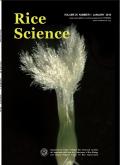A Meta-Analysis of 30 Years in China and Micro-District Experiments Shows Organic Fertilizer Quantification Combined with Chemical Fertilizer Reduction Enhances Rice Yield on Saline-Alkali Land
IF 5.6
2区 农林科学
Q1 AGRONOMY
引用次数: 0
Abstract
To improve the yield and quality of rice grown on saline-alkali soil, a meta-analysis combined with micro-district experimental studies was conducted in China to examine the impact of humic acid- based organic fertilizer and chemical fertilizer on rice yield and quality. This study employed a two-factor fully randomized experimental design, incorporating four levels of humic acid (F0, 0.0 g/pot; F1, 4.8 g/pot; F2, 12.0 g/pot; and F3, 19.2 g/pot) and three levels of chemical fertilizer (A1, full conventional dosage; A2, 85% of conventional dosage; and A3, 70% of conventional dosage). The meta-analysis revealed that the application of organic fertilizer (at a rate of 1500‒3000 kg/hm2) combined with chemical fertilizer had a significantly positive effect on the theoretical yield, tiller number, partial factor productivity, and SPAD value of rice. Temperature, organic fertilizer application, and chemical fertilizer levels were identified as critical factors affecting rice yield. The micro-experiments demonstrated that the application of humic acid organic fertilizer with treatment F3 significantly elevated the SPAD value at the full heading and grain filling stages. Increased panicle number and seed-setting rate were the main contributors to the rise in yield, with the F3 treatment yielding the highest overall. The effective leaf area, high-efficiency leaf area, and dry matter accumulation in rice treated with F3 were all higher compared with the F0 treatment. Our findings indicated that the addition of humic acid organic fertilizer can markedly improve the partial factor productivity and agronomic efficiency of rice. In conclusion, the application of F3 organic fertilizer combined with A3 chemical fertilizer (F3A3) significantly increased the yield of saline-alkali rice, which was 6.62% higher than that of the F0A1 treatment, thereby validating the meta-analysis outcomes. We propose that the combined use of humic acid organic fertilizer and chemical fertilizer can promote the growth of rice in saline-alkali soils. Consequently, these management practices provide a means to foster the green and healthy development of rice in saline-alkali regions across China.
中国30年的荟萃分析和微区试验表明,在盐碱地上,定量施用有机肥与减量施用化肥相结合可提高水稻产量
为提高盐碱地水稻的产量和品质,中国开展了一项荟萃分析与微区试验相结合的研究,探讨以腐植酸为基础的有机肥和化肥对水稻产量和品质的影响。该研究采用了双因素完全随机试验设计,包括四个腐植酸水平(F0,0.0 克/盆;F1,4.8 克/盆;F2,12.0 克/盆;F3,19.2 克/盆)和三个化肥水平(A1,全部常规用量;A2,常规用量的 85%;A3,常规用量的 70%)。荟萃分析表明,施用有机肥(施用量为 1500-3000 kg/hm2)和化肥对水稻的理论产量、分蘖数、部分要素生产率和 SPAD 值有显著的正向影响。温度、有机肥施用量和化肥水平被认为是影响水稻产量的关键因素。微试验表明,施用腐植酸有机肥 F3 处理可显著提高水稻全生育期和籽粒灌浆期的 SPAD 值。圆锥花序数和结实率的增加是产量提高的主要原因,其中 F3 处理的总体产量最高。与 F0 处理相比,F3 处理水稻的有效叶面积、高效叶面积和干物质积累都更高。我们的研究结果表明,添加腐植酸有机肥可显著提高水稻的部分要素生产率和农艺效率。总之,施用 F3 有机肥和 A3 化肥(F3A3)能显著提高盐碱地水稻的产量,比 F0A1 处理增产 6.62%,从而验证了荟萃分析的结果。我们认为,结合使用腐植酸有机肥和化肥可以促进水稻在盐碱地中的生长。因此,这些管理方法为促进中国盐碱地水稻的绿色健康发展提供了一种途径。
本文章由计算机程序翻译,如有差异,请以英文原文为准。
求助全文
约1分钟内获得全文
求助全文
来源期刊

Rice Science
Agricultural and Biological Sciences-Agronomy and Crop Science
CiteScore
8.90
自引率
6.20%
发文量
55
审稿时长
40 weeks
期刊介绍:
Rice Science is an international research journal sponsored by China National Rice Research Institute. It publishes original research papers, review articles, as well as short communications on all aspects of rice sciences in English language. Some of the topics that may be included in each issue are: breeding and genetics, biotechnology, germplasm resources, crop management, pest management, physiology, soil and fertilizer management, ecology, cereal chemistry and post-harvest processing.
 求助内容:
求助内容: 应助结果提醒方式:
应助结果提醒方式:


